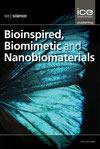3D Nanocomposite scaffold of TiO2 nanotubes incorporated carrageenan (TiO2NT/CG) for wound healing
IF 0.6
4区 工程技术
Q4 ENGINEERING, BIOMEDICAL
引用次数: 1
Abstract
3D nanocomposite scaffold is an important material for biomedical application owing to its compatibility and effectiveness compared with other types of nanocomposites. In this research, a unique 3D nanocomposite scaffold based on carrageenan biopolymer incorporating TiO2 nanotubes was successfully developed. Prior to the nanocomposite scaffold preparation, the TiO2 nanotubes as nanofiller were synthesized using the hydrothermal method. The synthesis of TiO2 nanotubes was incorporated into carrageenan for the fabrication of a 3D nanocomposite scaffold using the freeze-drying technique. The synthesized and fabricated materials were characterized using various techniques. Fourier-transform infrared spectroscopy and X-ray powder diffraction were employed to investigate the intermolecular interaction and phase structure of the fabricated TiO2 nanotubes incorporated carrageenan (TiO2NT/CG) 3D nanocomposite scaffold. The morphology and microstructure were via scanning electron microscopy and transmission electron microscopy. The ability of TiO2NT/CG 3D nanocomposite scaffold for wound healing was tested in vitro and in vivo. The in vitro study on 3T3 mouse fibroblast cells demonstrated that the number of cells increased up to 190 K per well. Meanwhile, in vivo studies on Sprague Dawley rat exhibited that a 100% cure rate of wounds was observed after 14 days. These are attributed to the presence of ∼10-nm TiO2 nanotubes that are homogeneously distributed onto the scaffold, as proven by scanning electron microscopy. The TiO2 nanotubes promote wound healing by generating reactive oxygen species to induce the fibroblast growth factor and for the formation of a new extracellular matrix. The interconnected porous structure and rough surface of the TiO2/GG 3D nanocomposite scaffold also support cell proliferation to expedite wound healing, thus offering a good candidate for wound-dressing application.含有角叉胶(TiO2 /CG)的TiO2纳米管三维纳米复合支架用于伤口愈合
与其他类型的纳米复合材料相比,3D纳米复合材料支架具有兼容性和有效性,是生物医学应用的重要材料。在这项研究中,成功地开发了一种基于卡拉胶生物聚合物结合TiO2纳米管的独特的三维纳米复合支架。在制备纳米复合支架之前,采用水热法合成了TiO2纳米管作为纳米填料。将TiO2纳米管的合成引入卡拉胶中,使用冷冻干燥技术制备3D纳米复合支架。使用各种技术对合成和制备的材料进行了表征。利用傅立叶变换红外光谱和X射线粉末衍射研究了制备的TiO2纳米管掺入卡拉胶(TiO2NT/CG)三维纳米复合支架的分子间相互作用和相结构。通过扫描电子显微镜和透射电子显微镜对其形貌和微观结构进行了分析。在体外和体内测试了TiO2NT/CG三维纳米复合支架的创伤愈合能力。对3T3小鼠成纤维细胞的体外研究表明,细胞数量增加到190 K。同时,对Sprague-Dawley大鼠的体内研究表明,14天后观察到100%的伤口治愈率。扫描电子显微镜证明,这是由于~10 nm TiO2纳米管均匀分布在支架上。TiO2纳米管通过产生活性氧来诱导成纤维细胞生长因子并形成新的细胞外基质,从而促进伤口愈合。TiO2/GG 3D纳米复合材料支架的互连多孔结构和粗糙表面也支持细胞增殖以加速伤口愈合,从而为伤口敷料应用提供了良好的候选者。
本文章由计算机程序翻译,如有差异,请以英文原文为准。
求助全文
约1分钟内获得全文
求助全文
来源期刊

Bioinspired Biomimetic and Nanobiomaterials
ENGINEERING, BIOMEDICAL-MATERIALS SCIENCE, BIOMATERIALS
CiteScore
2.20
自引率
0.00%
发文量
12
期刊介绍:
Bioinspired, biomimetic and nanobiomaterials are emerging as the most promising area of research within the area of biological materials science and engineering. The technological significance of this area is immense for applications as diverse as tissue engineering and drug delivery biosystems to biomimicked sensors and optical devices.
Bioinspired, Biomimetic and Nanobiomaterials provides a unique scholarly forum for discussion and reporting of structure sensitive functional properties of nature inspired materials.
 求助内容:
求助内容: 应助结果提醒方式:
应助结果提醒方式:


